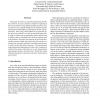Free Online Productivity Tools
i2Speak
i2Symbol
i2OCR
iTex2Img
iWeb2Print
iWeb2Shot
i2Type
iPdf2Split
iPdf2Merge
i2Bopomofo
i2Arabic
i2Style
i2Image
i2PDF
iLatex2Rtf
Sci2ools
113
Voted
DSN
2005
IEEE
2005
IEEE
Experimental Evaluation of the QoS of Failure Detectors on Wide Area Network
This paper describes an experiment performed on Wide Area Network to assess and fairly compare the Quality of Service provided by a large family of failure detectors. Failure detectors are a popular middleware mechanism used for improving the dependability of distributed systems and applications. Their QoS greatly influences the QoS that upper layers may provide. It is thus of uttermost importance to equip a system with an appropriate failure detector and to properly tune its parameters for the most desirable QoS to be provided. The paper first analyzes the QoS indicators and the structure of push-style failure detectors and then introduces the choices for estimators and safety margins used to build several (30) failure detectors. The experimental setup designed and implemented to allow a fair comparison of QoS of the several alternatives in a real representative experimental setting is then described. Finally the results obtained through the experiments and their interpretation are...
Related Content
| Added | 14 Oct 2010 |
| Updated | 14 Oct 2010 |
| Type | Conference |
| Year | 2005 |
| Where | DSN |
| Authors | Lorenzo Falai, Andrea Bondavalli |
Comments (0)

